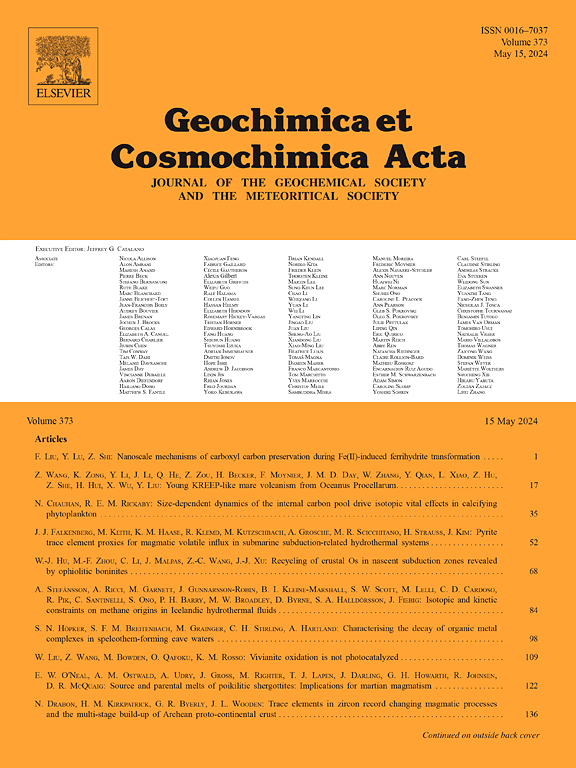Earth’s early differentiation recorded by halogen abundance ratios in Hawaiian lavas
IF 4.5
1区 地球科学
Q1 GEOCHEMISTRY & GEOPHYSICS
引用次数: 0
Abstract
Halogens (F, Cl, Br, I) and radiogenic isotopes were investigated in a suite of submarine basalt glasses from across the Hawaiian archipelago in order to better understand the origin of xenon isotope anomalies related to extinct 129I and the nature of metasomatic agents involved in peripheral Arch magmatism. We found that Lō’ihi tholeiites with high 3He/4He of up to 26 Ra (where Ra denotes the atmospheric 3He/4He) are characterised by unusually low I/Cl of (27 ± 3) × 10−6, whereas peripheral alkaline lavas from the South Arch that have 3He/4He of up to 18 Ra are characterised by unusually high I/Cl of (120 ± 20) × 10−6. In comparison, rejuvenated lavas with 3He/4He of ∼ 8 Ra have I/Cl in the range of (60 ± 30) × 10−6 that is typical of mid-ocean ridge and ocean island basalt lavas elsewhere. The variations in I/Cl, 3He/4He and radiogenic isotopes are consistent with mixing between three mantle end-members. The most primitive end-member with high 3He/4He and low 129XeI/136XePu has low I/Cl but normal Br/Cl, H2O/Cl and F/Cl ratios. Compared to the primitive mantle it is strongly depleted in I and weakly depleted in the other volatiles F, Cl, Br and H2O. The depletion of I (and 129Xe derived from extinct 129I) probably results from a combination of Earth’s heterogenous accretion and preferential partitioning of I into the Earth’s core. The high I/Cl of the South Arch lavas can be explained by input of low degree carbonatitic melts derived from carbonated eclogite in the plume source. This is implied because carbonated ocean crust is uniquely enriched in I. The involvement of carbonatitic melts is consistent with previously reported H2O, Ba and light rare earth element enrichments of South Arch lavas. Taken together the halogen abundance ratios in lavas sourced from around Hawaii record Earth’s early accretion and differentiation, the subsequent subduction of carbonated ocean crust into the mantle and its mobilisation in minor carbonatitic components enriching the periphery of the plume.
夏威夷熔岩中卤素丰度比记录的地球早期分化
为了更好地了解与绝灭的129I有关的氙同位素异常的来源以及外围Arch岩浆活动中交代物质的性质,研究了夏威夷群岛一套海底玄武岩玻璃中的卤素(F、Cl、Br、I)和放射性成因同位素。我们发现,高3He/4He高达26 Ra(其中Ra表示大气3He/4He)的lhi ' ihi拉斑岩具有异常低的I/Cl(27±3)× 10−6的特征,而来自南拱门的外围碱性熔岩具有高达18 Ra的3He/4He,具有异常高的(120±20)× 10−6的特征。相比之下,3He/4He为~ 8 Ra的复生熔岩的I/Cl在(60±30)× 10−6范围内,这是其他地方洋中脊和洋岛玄武岩熔岩的典型特征。I/Cl、3He/4He和放射性成因同位素的变化与三个地幔端元的混合相一致。最原始的端元具有较高的3He/4He和较低的129XeI/136XePu,具有较低的I/Cl,但正常的Br/Cl、H2O/Cl和F/Cl比值。与原始地幔相比,它的I含量较低,而其他挥发物F、Cl、Br和H2O含量较低。I的耗尽(以及129Xe源自已灭绝的129I)可能是地球非均质吸积和I优先分配到地核的共同作用的结果。南拱熔岩的高I/Cl可以解释为地幔柱源中碳酸化榴辉岩的低程度碳酸化熔体的输入。这是因为碳酸化洋壳在ⅰ区具有独特的富集特征。碳酸化熔体的参与与先前报道的南拱熔岩的H2O、Ba和轻稀土元素富集一致。综合夏威夷周围熔岩的卤素丰度比,记录了地球早期的增生和分化,随后碳酸化海洋地壳俯冲到地幔中,并以少量碳酸化成分的形式活动,丰富了地幔柱的外围。
本文章由计算机程序翻译,如有差异,请以英文原文为准。
求助全文
约1分钟内获得全文
求助全文
来源期刊

Geochimica et Cosmochimica Acta
地学-地球化学与地球物理
CiteScore
9.60
自引率
14.00%
发文量
437
审稿时长
6 months
期刊介绍:
Geochimica et Cosmochimica Acta publishes research papers in a wide range of subjects in terrestrial geochemistry, meteoritics, and planetary geochemistry. The scope of the journal includes:
1). Physical chemistry of gases, aqueous solutions, glasses, and crystalline solids
2). Igneous and metamorphic petrology
3). Chemical processes in the atmosphere, hydrosphere, biosphere, and lithosphere of the Earth
4). Organic geochemistry
5). Isotope geochemistry
6). Meteoritics and meteorite impacts
7). Lunar science; and
8). Planetary geochemistry.
 求助内容:
求助内容: 应助结果提醒方式:
应助结果提醒方式:


